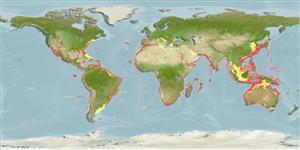Common names from other countries
Пластиножаберные (акулы и скаты) (sharks and rays) >
Carcharhiniformes (Ground sharks) >
Carcharhinidae (Requiem sharks)
Etymology: Carcharhinus: karcharos (Gr.), sharp or jagged; rhinus, an ancient name for sharks, from rhine (Gr.), rasp, both words alluding to a shark's jagged, rasp-like skin. (See ETYFish); obscurus: Latin for dark, probably referring to its darkish blue-gray body color. (See ETYFish).
More on author: Lesueur.
Environment: milieu / climate zone / depth range / distribution range
экология
морской; солоноватоводный ассоциированный с рифами; мигрирует в океане (Ref. 51243); пределы глубины 0 - 400 m (Ref. 244), usually 200 - 400 m. Subtropical; 45°N - 46°S, 120°W - 156°E (Ref. 55186)
Western Atlantic: southern Massachusetts to Florida (USA), Georges Bank, Bahamas, Cuba, northern Gulf of Mexico, Nicaragua, southern Brazil and Uruguay (Ref. 58839). Eastern Atlantic: Canary Islands, Cape Verde, Senegal, Sierra Leone. Some records from the Mediterranean and Madeira may be based on Carcharhinus galapagensis. Indo-West Pacific: Red Sea (Ref. 5485), Mozambique and South Africa to Japan, China, Viet Nam and Australia. Eastern Pacific: southern California, USA to Gulf of California and the Revillagigedo Island. Highly migratory species.
Length at first maturity / Size / Вес / Возраст
Maturity: Lm 249.5, range 220 - 300 cm
Max length : 420 cm TL самец/пол неопределен; (Ref. 5578); common length : 250 cm TL самец/пол неопределен; (Ref. 26999); наибольший вес (опубликованные данные): 346.5 kg (Ref. 4699); наибольший возраст (опубликованны данные): 40 годы (Ref. 31395)
колючие лучи спинного плавника (общее число) : 0; колючие лучи анального плавника: 0. A large shark with a broadly rounded snout, triangular saw-edged upper teeth, curved moderate-sized pectoral fins, and an interdorsal ridge (Ref. 5578). Blue-grey, lead-grey above, white below; tips of pectoral and pelvic fins, as well as lower lobe of caudal fin and dorsal fins often dusky in young, plain in adults (Ref. 9997).
Found in coastal and offshore waters but not oceanic (Ref. 5578). Adults are commonly found at depths of 200-400 m, young in shallower waters (Ref. 5485). A seasonal migratory species over parts of its range (Ref. 6871). Common component of the catch of the shark longline fishery (Ref.58048). Feeds on bottom and pelagic bony fish, sharks, skates, rays, cephalopods, gastropods, crustaceans, sometimes mammalian carrion and inorganic objects (Ref. 5578). Viviparous (Ref. 50449); with litter size number from 3-14 (Ref. 27549). Large adults are potentially dangerous (Ref. 4716, 6871). Utilized fresh, dried-salted, frozen and smoked for human consumption; hides for leather; fins for sharks-fin soup; and liver oil extracted for vitamins (Ref. 244).
Viviparous, with a yolk-sac placenta, litter size 3-14 pups (Ref. 244); 70-100 cm at birth (Ref. 6871). Gestation period of ~ 16 months (Ref.58048). Distinct pairing with embrace (Ref. 205).
Compagno, L.J.V., 1984. FAO Species Catalogue. Vol. 4. Sharks of the world. An annotated and illustrated catalogue of shark species known to date. Part 2 - Carcharhiniformes. FAO Fish. Synop. 125(4/2):251-655. Rome: FAO. (Ref. 244)
Статус Красного Списка МСОП (Ref. 130435)
Угроза для людей
Traumatogenic (Ref. 4690)
Использование человеком
Warning: mysqli::__construct(): (HY000/1040): Too many connections in /var/www/html/includes/func_getlabel.php on line 46
Can't connect to MySQL database (fbapp). Errorcode: Too many connections
